I’m in the process of moving the site to a new hosting service with a new domain name.
I’ll be back to normal shortly.
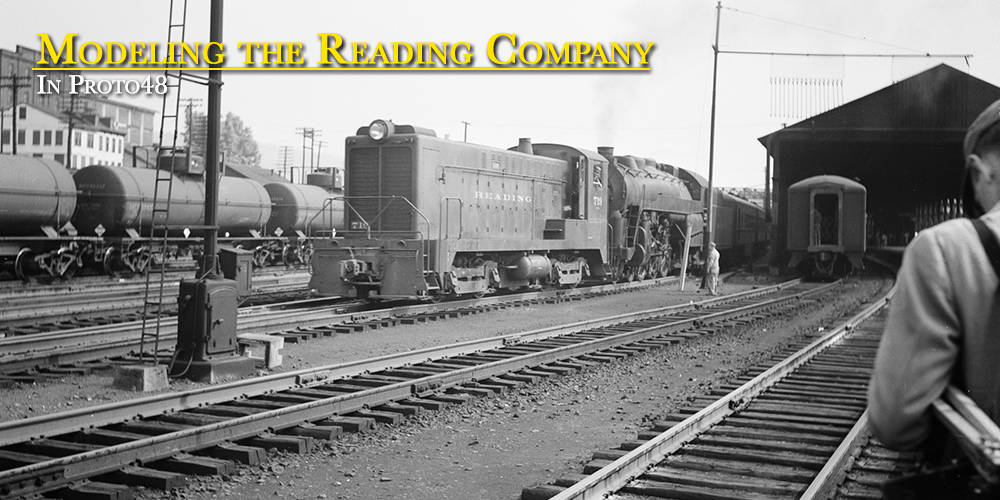
While at the Strasburg show I picked up a pair of the new Yoder Vulcan p48 trucks. The Yoder website shows the trucks are out of stock in P48, but he had some on the table at the show. The trucks come fully assembled and include a screw so that they could be mounted onto one of Rich’s models.
I had held back before on buying these because I have several pair of San Juan’s Vulcan truck on the shelf and really did not know much about the design. When I got home and set the truck next to a San Juan truck, I was pleased to see that they were different. This started a little digging to find out some more information about the trucks.
I looked at the article “Arch Bars to Roller Bearing, Freight car trucks 1900-1960″ by Richard Hendrickson in Volume 4 of the Railway Prototype Cyclopedia. Where I found out the Vulcan truck was manufactured by American Steel Foundries in the early 1920′s. They were similiar to Andrews trucks of the time, with a cast steel side frame with seperate journal boxes. Where they differed is that the Vulcan design eliminated the need for a bottom retainer bars by bolting the journal box into pedestal jaws.
The article show photos of two different Vulcan designs one an earlier L-section and one a later U-section side frame castings.
In Robert Karig’s book, Coal Cars the first three hundred years, he speaks of the Vulcan design in chapter six on Freight car trucks. “George G. Floyd was awarded a patent for a side frame with pedestal mounted journal boxes on May 3, 1910. It served as the foundation patent for the American Steel Foundries’ Vulcan side frame. Initially built in a T-Section form, the Vulcan frame was ultimately converted to a channel-section design.”
I was also surprised to see that Rich’s trucks were completly within NMRA spec for P48. Not all of the trucks I have measured before from Rich for Standard O scale were, so this was great news. The San Juan truck does have nice casting letting on the truck sideframes that the Yoder’s are lacking.
Rich Yoder and John Dunn put on another O Scale Show in Strasburg on August 6, 2011. The show was very well attended and there were a number of new things to see at the show. One of the bigger items that was on a couple of tables was Weaver’s new Lackawanna Pocono 4-8-4, one of them is in the lead photo on theis post.
Rich Yoder also had his new Mathieson Dry Ice car. I didn’t photograph the car because I was to busy going through his stock of trucks. One his table he had O scale and P48 versions of two new trucks, the PRR 2F-F2 and the PRR 2D-F12. I’ve added the measurements for the new trucks into the P48 Wheel Standards page.
I was also able to pick up an older Precision Scale Co. C&O 50 ton twin class H5 with flat ends. We had been talking about this car on the Proto48 modelers board. Turns out this car is correct for one order of theErieoffset twins and is different than the Yoder cars that are correct for theErie. I’ll post more on that later this week.
I had the chance to meet and talk for a while to Jack Hill at the show. It was very nice to put a face with the models that I’ve seen in his blog.
After a nice morning of buying and selling, I had the pleasure of going to lunch at Jenny’s Diner on US 30 with other p48′ers, such as Martin Latowsky. That is starting to turn into a regular P48 Lunch outing.
The plot thickens……
My brother Bobb sent this partial scan to tease me a little today. It’s from a lettering diagram for Reading and CNJ switchers. The drawing was first released on 12/7/38 and is updated through 1944.
It does identify “Duco Pullman Green -(Reading Railroad Standard)- No. 254-1374″
Now to research the modern version of that paint. Still might not be what’s on the AS-16′s, but it’s another step closer.
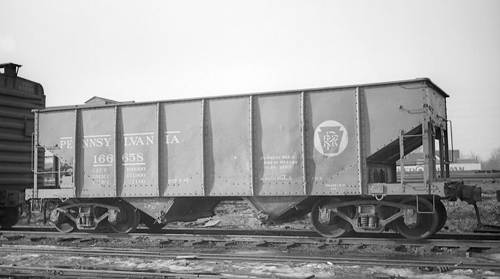
PRR 166658 GLa – George Losse collection
The Pennsylvania Railroad class GLa is a 50 ton twin open hopper car. Construction began in 1904 and continued through 1991. A total of 30,256 were built for the PRR or acquired from various coal companies that built the same design.
The April 1956 OER lists 21,840 GLa’s on the roster. Compare this to Reading’s 13015 total hopper cars, or Western Maryland’s 8006 total hopper cars and you begin to see the size of the PRR fleet of GLa’s.
The GLa was originally built with K brakes and later converted to AB. Very few GLa were updated with power brake wheels most cars retained their verticle brake staff. One exception would be the second hand cars acquired from Berwind-White, which had modern power hand brake hardware.
It’s interesting to note that the overall dimensions of the GLa are close to the USRA Standard 50-Ton Twin Hopper which was designed almost 15 years later. Inside Length is one inch shorter at 30′ 5″. Inside width 9′ 5 1/2″ is a half an inch wider then the USRA Twin. The GLa is 8″ shorter to the top of side cord at 10′ 0″ but the side height is only 5″ shorter as the bottom of the car side sits three inches lower than the USRA Twin. The GLa has a capacity only 197 cu. ft. less that the USRA Twin. These similiarities will work in our favor when it comes time to build a fleet of these cars.
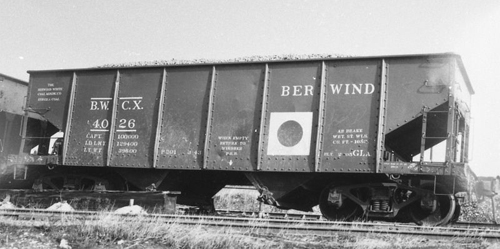
BCWX 4026 GLa – George Losse collection
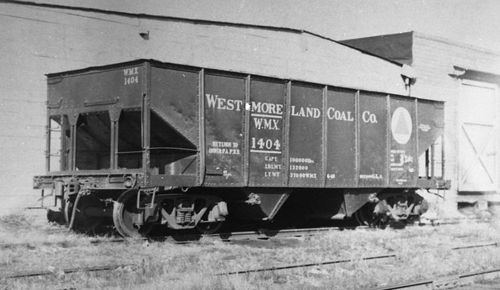
WMX 1404 GLa – George Losse collection
References:
Keystone Article
PRR Steel Open Hopper Cars – John Teichmoeller
January 1952 Official Railway Equipment Register
September 1953 Official Railway Equipment Register
April 1956 Official Railway Equipment Register
O Scale Models:
Chooch #674 Pullman Flat Car – Ultra Scale line of resin cars.
Wiseman Model Services appears to be producing a similar kit.
The History:
The American Association of Railroads (AAR) Committee on Car Construction established a standard for 53’ 6” flat cars based upon a 1941 Pullman-Standard Company design. The earliest users of this design were the Chicago Great Western, Monon, Soo and UP. The design established a new standard for deck height of 42” which was lower than previous car designs. This feature would permit taller loads without exceeding established clearance limits. It also had a much wider deck extending beyond the fishbelly sides. Twenty railroads built 2532 cars to this basic design.
The car spanned a long period of operation ranging from 1941 to the 1980’s. Some roads converted these cars into piggyback carriers or fitted them with bulkheads for building materials. Many of the cars ended up in maintenance of way service after a long revenue life.
Following chart from Chooch website:
* Information off of the Chooch website |
||||||||||||||||||||||||||||||||||||||||||||||||||||||||||||||||||||||||||||||||||||||||||||||||||||||||||||||||||||||||||||||||||||||||||||||||||||||||||||||||
Pullman Standard introduced its PS-1 boxcar in the late 1947. There are a number of articles about the PS-1’s in the Hobby press. I’m not going to restate everything that has been written about this design of cars.
Ed Hawkins and Ted Culotta compiled a list of all the PS-1’s built. The complete list of Pullman PS-1 boxcars can be found on the Steam Era Freight Car Website.
Below is a modified version of their information sorted by the build-date of the cars built before my modeling period, the Summer of 1952.
Pullman Standard built a total of 77,570 cars, but by 7/52 only 46,847 had been built. These are the only cars that existed and could have been seen by my modeling period, so this is a list of the only cars that can be on the layout. Now I don’t plan to build every one of these, but the four or five I do plan to build are on this list.
This will also give me other other information then just what details are on the car and which road. By knowing if the car is less than one year old it means it should look close to brand new. Or if it’s one of the LV car built in 1947 it should look like it has been in service for five years.
Lionel and Weaver both make version of this car in O scale. The Lionel car is available with a 6ft, 7ft and 8ft door. The Weaver is only available with an 8ft door. Protocraft makes a number of decals for these cars, I’ve linked the reporting mark (first column) to the decal pages with photos of the cars.
| Road | Series | Qty | Built | Lot No. | Door | Type | Trucks |
| LV | 62000-62499 | 500 | 6-47 | 5873 | 7 | 7P Sup1 | S2(SP) |
| CGW | 93001-93500 | 500 | 8-47 | 5875 | 6 | 7P Sup1 | S2A |
| BM | 74000-74499 | 500 | 9-47 | 5877 | 7 | 7P Sup1 | A3 |
| MEC | 6500-6749 | 250 | 10-47 | 5877 | 7 | 7P Sup1 | A3 |
| ATSF | 276500-276749 | 250 | 11-47 | 5879 | 6 | 7P Sup1 | A3 |
| NH | 34000-34499 | 500 | 11-47 | 5894 | 7 | 7P Sup1 | A3 |
| NH | 33500-33999 | 500 | 12-47 | 5882 | 7 | 7P Sup1 | A3 |
| KCS | 18150-18549 | 400 | 12-47 | 5885 | 6 | 7P Sup1 | A3 |
| NKP | 6600-6999 | 400 | J-48 | 5887A | 7 | 7P Sup1 | A3 |
| C&O | 15000-15999 | 1000 | 2-48 | 5886 | 6 | 7P Sup1 | A3 |
| NKP | 6000-6599 | 600 | 2-48 | 5887 | 7 | 7P Sup1 | A3 |
| Southern | 23487-26486 | 3000 | 2-48 | 5896 | 8 | 7P Sup1 | S2A |
| KCS | 18550-18949 | 400 | 3-48 | 5895 | 6 | 7P Sup1 | A3* |
| NYC | 167000-167999 | 1000 | 3-48 | 5904 | 6 | 7P Sup1 | S2A* |
| SAL | 22450-22949 | 500 | 4-48 | 5888 | 14 | 7P Sup1 | A3 |
| NH | 34500-34999 | 500 | 4-48 | 5894 | 7 | 7P Sup1 | A3 |
| NH | 35000-35999 | 1000 | 4-48 | 5907 | 7 | 7P Sup1 | A3 |
| UP | 100000-101599 | 1600 | 6-48 | 5908 | 6 | 7P Sup2 | S2A |
| SL-SF | 17000-17299 | 300 | 7-48 | 5911 | 8 | 7P Sup2 | A3 |
| RI | 25500-26499 | 1000 | 8-48 | 5919 | 6 | 7P Sup2 | A3 |
| COPR | 4010-4024 | 15 | 8-48 | 5908A | 6 | 7P Sup2 | S2A |
| CNW | 86300-88298 | 1000 | 9-48 | 5920 | 6 | 7P Sup2 | A3 |
| SA | 8200-8249 | 50 | 9-48 | 5896A | 8 | 7P Sup1 | ANDREWS |
| SAL | 24000-24499 | 500 | 10-48 | 5919B | 8 | 7P Sup2 | A3 |
| CMO | 39100-39498 | 200 | 11-48 | 5919A | 6 | 7P Sup2 | A3 |
| CNW | 88300-88382 | 42 | 11-48 | 5919A | 6 | 7P Sup2 | A3 |
| COPR | 4025-4032 | 8 | 11-48 | 5919A | 6 | 7P Sup2 | A3 |
| DSS&A | 15000-15099 | 100 | 11-48 | 5919A | 6 | 7P Sup2 | A3 |
| P&WV | 1300-1399 | 100 | 11-48 | 5919A | 6 | 7P Sup2 | A3 |
| DL&W | 35000-35199 | 200 | 12-48 | 5936 | 6 | 7P Sup2 | S2A |
| Southern | 26487-26527 | 41 | 12-48 | 5919A | 6 | 7P Sup2 | A3? |
| Southern | 262050-262055 | 6 | 12-48 | 5919A | 6 | 7P Sup2 | A3 |
| Southern | 307023-307024 | 2 | 12-48 | 5919A | 6 | 7P Sup2 | A3? |
| Southern | 330500 only | 1 | 12-48 | 5919A | 6 | 7P Sup2 | A3? |
| MSC | 5000-5099 | 100 | 6-49 | 5942 | 6 | YSD-2 | A3 |
| CIL | 501-530 | 30 | 6-49 | 5942A | 6 | YSD-2 | A3 |
| CP | 269600-269999 | 400 | 7-49 | 5950 | 6 | YSD-2 | S2A |
| LS&BC | 1100-1119 | 20 | 8-49 | 5950 | 6 | YSD-2 | S2A |
| CNW | 106600-108598 | 1000 | 8-49 | 5955 | 6 | YSD-2 | A3 |
| CIL | 532 only | 1 | 10-49 | 5950 | 6 | YSD-2 | S2A |
| MKT | 90001-90079 | 79 | 10-49 | 5950 | 6 | YSD-2 | S2A |
| CNW | 57400-57898 | 250 | 11-49 | 5957 | 15 | YSD-2 | A3 |
| NYC | 169750-170499 | 750 | J-50 | 5965 | 6 | YSD-2 | |
| ATSF | 31250-31749 | 500 | 5-50 | 5964 | 6 | YSD-2A | A3 |
| L&N | 16800-17299 | 500 | 5-50 | 5966A | 6 | YSD-2 | A3 |
| L&N | 17300-17799 | 500 | 6-50 | 5966B | 6 | 7P Sup3 | A3 |
| NYC | 169000-169749 | 750 | 7-50 | 5965 | 6 | 7P Sup3 | A3* |
| LV | 62500-62999 | 500 | 9-50 | 5970 | 7 | 7P Sup3 | A3 |
| LS&I | 2226-2275 | 50 | 9-50 | 5965A | 6 | 7P Sup3 | A3 |
| D&H | 18400-18899 | 500 | 10-50 | 5973 | 6 | YSD-2 | A3* |
| GBW | 700-899 | 200 | 11-50 | 5977 | 6 | 7P Sup3 | A3 |
| USAX | 26021-26120 | 100 | 12-50 | 5980 | 8 | 7P Sup3 | A3 |
| C&O | 16000-16999 | 1000 | 12-50 | 5983 | 8 | YSD-2 | A3 |
| L&N | 14600-14999 | 400 | J-51 | 5988 | 6 | YSD-2 | A3 |
| NYC | 171000-171499 | 500 | J-51 | 5993 | 6 | 7P Sup3 | |
| NYC | 172000-172499 | 500 | J-51 | 5997 | 6 | YSD-2 | |
| NYC | 170500-170999 | 500 | 2-51 | 5993 | 6 | YSD-2 | A3* |
| C&EI | 65500-65699 | 200 | 2-51 | 5996 | 6 | 7P Sup3 | A3 |
| D&H | 18900-19399 | 500 | 2-51 | 5998 | 6 | YSD-2 | A3* |
| USAX | 26125-26318 | 194 | 3-51 | 8008 | 8 | 7P Sup3 | A3 |
| BM | 75000-75749 | 750 | 4-51 | 5999 | 7 | YSD-2 | A3 |
| SAL | 24500-24999 | 500 | 5-51 | 5994 | 8 | YSD-2 | A3 |
| NYC | 171500-171999 | 500 | 5-51 | 5997 | 6 | 7P Sup3 | A3* |
| MEC | 8000-8249 | 250 | 5-51 | 5999A | 7 | YSD-2 | A3 |
| SL-SF | 17300-17799 | 500 | 6-51 | 5995 | 8 | YSD-2 | A3 |
| N&W | 44000-44499 | 500 | 6-51 | 8002 | 8 | YSD-2 | A3* |
| ACY | 700-849 | 150 | 6-51 | 8004 | 6 | YSD-2 | A3 |
| CGW | 5001-5600 | 600 | 6-51 | 8016 | 6 | YSD-2 | S2A |
| CNW | 6200-7398 | 600 | 7-51 | 8007 | 6 | 7P Sup3 | A3 |
| CNW | 7400-10198 | 1400 | 7-51 | 8007 | 6 | YSD-2 | A3 |
| USAFX | 26319-26323 | 5 | 7-51 | 8044 | 8 | YSD-2 | A3 |
| USAFX | 26474-26481 | 8 | 7-51 | 8044 | 8 | YSD-2 | |
| USAX | 26324-26473 | 150 | 7-51 | 8044 | 8 | YSD-2 | |
| USMC | 173227-173236 | 10 | 7-51 | 8044 | 8 | YSD-2 | A3 |
| USN | 02455-02463 | 9 | 7-51 | 8044 | 8 | YSD-2 | A3 |
| USN | 02698-02727 | 30 | 7-51 | 8044 | 8 | YSD-2 | |
| C&O | 17000-17999 | 1000 | 9-51 | 8017 | 8 | YSD-2 | A3 |
| L&N | 17800-18399 | 600 | 10-51 | 5988 | 6 | YSD-2 | A3 |
| MILW | 35000-35041 | 42 | 10-51 | 8025 | 6 | 7P Sup3 | S2A* |
| SSW | 33950-34049 | 100 | 10-51 | 8026 | 8 | YSD-2 | A3 |
| WP | 20801-20820 | 20 | 10-51 | 8027 | 7 | YSD-2 | A3 |
| WP | 20821-21400 | 580 | 10-51 | 8027 | 7 | YSD-2 | A3 |
| Southern | 30000-30499 | 500 | 11-51 | 8003 | 9 | YSD-2 | S2A |
| Southern | 30500-32018 | 1519 | 11-51 | 8003 | 9 | 7P Sup3 | |
| Southern | 262056-262059 | 4 | 11-51 | 8003 | 8 | 7P Sup3 | |
| Southern | 307028 only | 1 | 11-51 | 8003 | 8 | 7P Sup3 | |
| Southern | 330501 only | 1 | 11-51 | 8003 | 8 | 7P Sup3 | |
| RI | 21000-21749 | 750 | 11-51 | 8028 | 6 | 7P Sup3 | S2A |
| RI | 21750-22249 | 500 | 11-51 | 8028 | 6 | YSD-2 | S2A |
| RI | 22250-22999 | 750 | 12-51 | 8028 | 6 | 7P Sup3 | S2A* |
| L&C | 1000-1019 | 20 | 1-52 | 8003 | 9 | 7P Sup3 | S2A |
| BS | 6700-6749 | 50 | 1-52 | 8009 | 6 | 7P Sup3 | S2A |
| CNW | 6766 only | 1 | J-52 | 8083 | 6 | 5P Sup | |
| CNW | Various | 3 | J-52 | 8083 | 6 | 5P Sup | |
| BS | 6750-6799 | 50 | 2-52 | 8009 | 6 | PS | S2A |
| NC&StL | 22000-22649 | 650 | 2-52 | 8015 | 6 | YSD-2 | A3 |
| N&W | 44500-44999 | 500 | 2-52 | 8035 | 8 | YSD-2 | S2A* |
| GA | 39501-39550 | 50 | 3-52 | 8021 | 6 | YSD-2 | A3 |
| WofA | 18100-18209 | 110 | 3-52 | 8021 | 6 | YSD-2 | A3 |
| SAL | 25000-25499 | 500 | 3-52 | 8029 | 8 | YSD-2 | A3 |
| L&N | 5000-7199 | 2200 | 3-52 | 8039 | 8 | YSD-2 | A3 |
| CG | 7000-7299 | 300 | 4-52 | 8030 | 8 | YSD-2 | S2A |
| C&O | 18000-18499 | 500 | 6-52 | 8037 | 8 | YSD-2 | S2A |
| C&O | 18500-18999 | 500 | 6-52 | 8037 | 8 | 6P Sup1 | S2A |
| ASX | 712-811 | 100 | 6-52 | 8069 | 6 | 5P Sup | A3 |
| NYC | 180000-180499 | 500 | 6-52 | 8036A | 6 | 5P Sup | A3 |
| BCK | 1000-1499 | 500 | 7-52 | 8038 | 7 | 5P Sup | A3 |
| FDDM&S | 12201-12400 | 200 | 7-52 | 8036B | 6 | 5P Sup | A3 |
| CP | 268800-269099 | 300 | 7-52 | 8036C | 6 | 5P Sup | S2A |
| LS&I | 2400-2489 | 90 | 8-52 | 8047 | 8 | YSD-2 | A3 |
| VGN | 63100-63399 | 300 | 8-52 | 8048 | 8 | YSD-2 | A3/S2B |
References:
Ed Hawkins PS-1 list on the Steam Era Freight Car Website
Mainline Modeler Article
Bert Pennypacker speaks about the Reading Mallets 2-8-8-2 in his Mainline Modeler article on the K1’s. They were built by Baldwin beginning with six locomotives received in 1917. Two additional orders brought the fleet up to 31 locomotives by 1919 and were classes N1-sa/b/c. They were numbered 1800-1830, with 55.5 inch drivers and 98,400 lbs of tractive force.
The mallets were distributed in different parts of the system, 11 were running between Hagerstown-Rutherford-Allentown, two were assigned to Reading as Temple Hill pushers, and the rest were were distributed through the coal regions, West Cressona, St.Clair, Tamaqua, Gordon and Shamokin. The locomotives assigned to pusher duties were given small capacity tenders, 8,000 gallons and12.8 tons of coal. While the road mallets were given larger tenders with 11,000 gallon and 18 ton capacity. Wages were cheap and pusher runs were short, no need for big tenders.
It was said of the Mallets that they could pull anything slowly. The Reading most not have been totally happy with the speed of the N1’s in road service. Beginning in 1927, locomotives #1800-1810 (11) were rebuilt into the K1 2-10-2 locomotives. They were only ten years old at the start of the project. Their boilers were reused and most of their parts in the rebuilding project.
Then in 1930 the railroad began converting the mallets from compound to single expansion cylinders. They were re-classed as N1-sd. The big delivery pipes on the side of the smoke box are an indication of the converted locomotives. All the N1’s were converted by 1945. They also had their trailing trucks removed between 1940-1944.
In the late 1940’s ten N1-sd’s received new smoke boxes and cross-compound air pumps relocated onto the smoke box front. The locomotive that had the forward mounted air pumps were numbered; 1811, 1812, 1817, 1820, 1822, 1823, 1826, 1828, 1829 and 1830.
References:
Mainline Modeler, May/June 1981 – “Reading 2-10-2 It should have been a Texas” by Bert Pennypacker
Reading Steam Pictorial
Photograph’s from George Losse Collection scanned from prints and/or original negatives.
The Reading received their first 1000 HP. switcher form EMD in the form of an NW2 #90, on September 5, 1940. This missed out being the first 1000 HP. switcher on the Reading by three weeks to #80 a Baldwind VO-1000.
NW2’s numbered #91-92 arrived in early October of 1941. After World War 2 was over the Reading added five more NW2’s to the roster numbers #100-104.The second series of NW2’s differed slightly from the first three by having louvers in the engine compartment doors.
The First three were originally assigned to the Shamokin Division. Eventually, they migrated to other parts of the railroad.
All the locomotives were delievered in the Pullman Green scheme. None were repainted into the green and Yellow scheme. One locomotive #104 was repainted into the last solid green scheme. Not all switcher received the rain gutters, #91 was photographed in 1963 without gutters.
| No. | Built | Model | Notes | Engine House Assignment | Photos on this Site | Photo Online |
| 90 | Sep-40 | NW2 | No Louvers | Photo – Photo | ||
| 91 | Oct-41 | NW2 | No Louvers | Photo | ||
| 92 | Oct-41 | NW2 | No Louvers | Photo – Photo | ||
| 100 | Jul-47 | NW2 | Louvers | Photo – Photo | ||
| 101 | Jul-47 | NW2 | Louvers | Photo – Photo | ||
| 102 | Jul-47 | NW2 | Louvers | |||
| 103 | Jul-47 | NW2 | Louvers | |||
| 104 | Jul-47 | NW2 | Louvers | Photo – Photo – Photo |
References:
Diesel Era – 1996 March/April – Reading’s Repowered Switchers.
Diesel Era – 1998 March/April – Reading’s First-Generation Diesels by by Paul K. Withers
Reading Diesels Volume 1 The First Generation – by Dale Woodland
Photograph’s from George Losse Collection scaned from negatives.
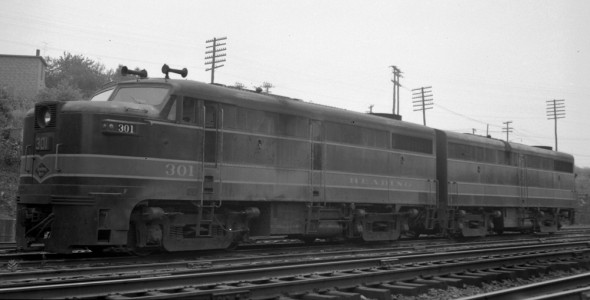
| Number | Built | RDG Class | HP | Engine House Assignment |
| 300 | 6/48 | DF-3 | 1600 | |
| 300 B | 6/48 | DF-3 | 1600 | |
| 301 | 6/48 | DF-3 | 1600 | |
| 301 B | 6/48 | DF-3 | 1600 | |
| 302 | 6/48 | DF-3 | 1600 | |
| 302 B | 6/48 | DF-3 | 1600 | |
| 303 | 6/48 | DF-3 | 1600 | |
| 303 B | 6/48 | DF-3 | 1600 | |
| 304 | 6/48 | DF-3 | 1600 | |
| 304 B | 6/48 | DF-3 | 1600 | |
| 305 | 6/48 | DF-3 | 1600 | |
| 305 B | 6/48 | DF-3 | 1600 |
References:
Reading Diesels Volume 1 The First Generation – by Dale Woodland
Photograph’s from George Losse Collection.